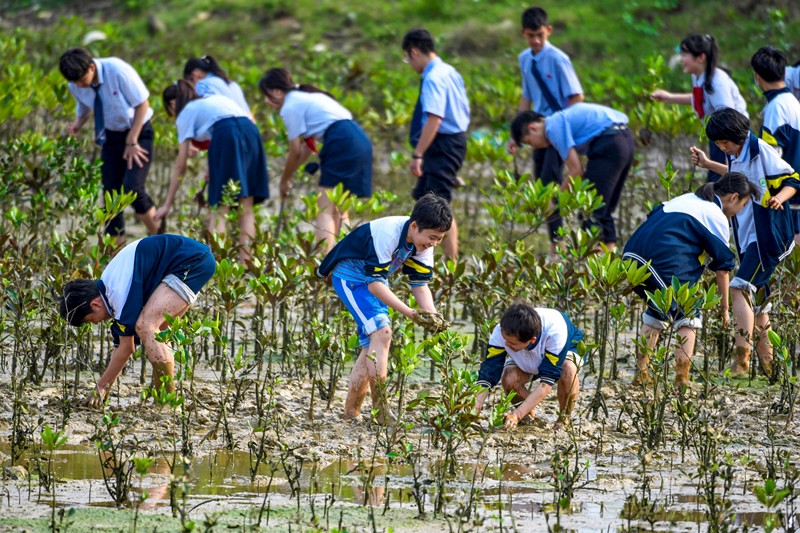China vigorously promotes protection of marine biodiversity (2)
June 8 marked the 13th World Oceans Day, whose theme this year is “The Ocean: Life and Livelihoods”. The day also marked the 14th National Marine Awareness Day of China, which has paid close attention and made continuous efforts to protect marine biodiversity.
China is one of the countries with the richest marine biodiversity in the world. It has over 28,000 marine species on record, which account for about 13 percent of the world’s total, ranking third in the world.
In recent years, China has vigorously pushed ahead with the promotion of marine biodiversity and reaped the rewards for its efforts.
There are more than 35,000 known fish species in the world, among which over 32,000 live in the ocean. China has recorded over 4,500 fish species, including more than 3,700 kinds of marine fish.
The country has conducted investigations into marine fish biodiversity and carried out researches on the protection and restoration of marine fish biodiversity in the Bohai Sea, Yellow Sea, East Sea, and other waters in China.
In the East Sea, China has undertaken research on the protection and restoration of large yellow croaker resources. Relevant researchers analyzed the reasons behind the decline in large yellow croaker resources in such aspects as characteristics of hydrological environment, biological features of the marine fish population as well as trophic structure of the food web in the ecosystem, and adopted measures like optimizing artificial enhancement and releasing of large yellow croakers and setting up marine protected areas in a bid to protect marine fish biodiversity.
Mangroves, a typical marine ecosystem, can be found in over 100 countries, including China.
Over 800 species of benthic animals, including many endangered species, have been found live in China’s mangrove trees, which mainly grow in the country’s Guangdong province, Guangxi Zhuang autonomous region, and Hainan province.
China is one of the few countries in the world with a net increase in the area of mangroves. Strengthening the protection and restoration of mangroves has always been an important part of the country’s marine ecological protection and restoration efforts.
Under the guidance of China’s Ministry of Natural Resources (MNR), local governments in coastal regions have implemented the Blue Bay Initiative, which aims to improve marine ecology. Driven by the initiative, China has established over 50 protected areas for mangroves.
Chinese white dolphins are sometimes seen swimming in the waters near Xiamen city, southeast China’s Fujian province.
Over the past more than one decade, the Third Institute of Oceanography under the MNR has conducted long-term field investigation into the Chinese white dolphins in the Xiamen Bay near the city.
Latest research data from the institute show that the population of the animal stands around 60, and has basically maintained stable.
Chinese white dolphins mainly inhabit the nearshore waters and estuaries along the southeastern coast of China. As an alpha predator in its surrounding ecosystems, the animal indicates the condition of the ecosystems in coastal waters and estuaries.
Coral reefs are considered one of the ecosystems with the richest biodiversity and highest productivity, and hailed as tropical rainforests of the sea.
Relevant institutions in China have carried out plenty of research on and achieved many results in the comprehensive observation of coral reefs, breeding of hermatypic corals, coral reef degradation and adaptation mechanisms, and coral reef ecological restoration technologies.
China’s coral reefs, which rank eighth in the world in terms of area, are mainly found in the country’s Hainan, Guangdong, Guangxi, Fujian, and the South China Sea islands.
Since 2000, China has conducted many biological survey voyages, during which the country has continuously improved its survey platforms and equipment, and made new breakthroughs and progress in exploration as well as research and development.
Based on these breakthroughs and progress, China has gradually built resource pools including a database of deep-sea bacteria, completed a great deal of research on the classification and systematic evolution of many new marine microorganisms, and evaluated the potential of microbial resources for application in marine biological medicine and biotechnology.
 |  |
Photos
Related Stories
- China marks World Oceans Day with a focus on protecting marine biodiversity
- Subsidiary event of COP15 meeting on biodiversity kicks off in China's Kunming
- Once-dwindling freshwater lake on grassland regains vitality
- Countries need to foster synergy in restoring biodiversity
- Guided by Xi's environmental vision, China champions biodiversity
- Experts investigate biodiversity in Longquan City, Zhejiang
- U.S. second busiest port sees record-high biodiversity in green port efforts
- Yunnan gears up for biodiversity protection
- Restoring Earth, China on the move to achieve carbon neutrality, more biodiversity
- Feature: Biodiversity conservation goes mainstream in China
Copyright © 2021 People's Daily Online. All Rights Reserved.











